In recent trading, Bitcoin (BTC) has soared to over $100,000, marking a significant milestone in its ongoing bull run. This surge follows a notable pattern of price increases, with Bitcoin previously hitting around $73,000 earlier in March 2024. This rise can be attributed in part to the U.S. Securities and Exchange Commission (SEC) granting approval for several exchange-traded funds (ETFs), allowing more investors to participate in the market. Bitcoin’s price fluctuated throughout October, momentarily dipping into the $60,000 range before rebounding to set a new all-time high of $75,000 by early November. A striking surge occurred on November 13 when BTC crossed the $90,000 mark, underscoring the volatility and upward trajectory of the cryptocurrency.
Various factors may have fueled Bitcoin’s recent price movements. The announcement of Donald Trump’s victory in the presidential race has reportedly invigorated investor sentiment, particularly among Bitcoin enthusiasts. Trump expressed intentions to establish a BTC “strategic reserve” and actively courted the support of the cryptocurrency community during his campaign. The impending departure of SEC Chairman Gary Gensler, considered a contentious figure in the crypto realm, further bolstered positive sentiment as investors anticipate a more favorable regulatory environment under Trump’s administration. Such political developments may have heightened investor optimism, contributing to the recent price surge of Bitcoin.
Central to Bitcoin’s enduring rise is its “halving” event—a process that reduces the mining rewards for Bitcoin by half every four years, thus tightening the supply of new coins entering the market. The latest halving occurred in April 2024, and historically, this event tends to lead to significant price appreciation approximately five months thereafter. This cycle of price discovery has been consistent since Bitcoin’s inception, manifesting in patterns of rapid price growth followed by corrections to levels that still surpass the highs reached in previous cycles. Traders and investors often anticipate these cycles, which add layers of speculation and excitement to the BTC market.
The controlled supply mechanism inherent in Bitcoin is expected to foster a deflationary monetary environment, contrasting sharply with the inflationary nature of traditional fiat currencies like the U.S. dollar. Typically, fiat systems are designed to encourage spending rather than saving, leading to devaluation over time. In contrast, Bitcoin’s design incentivizes holding and potentially increases its value over time as scarcity grows. This deflationary quality is appealing to those seeking to preserve wealth over the long term and represents a departure from conventional central banking practices, drawing many to consider Bitcoin as a viable alternative.
Historically, the middle class has turned to the stock market as a hedge against inflation, incurring significant costs and fees in the process. Bitcoin’s rising prominence offers a new avenue for wealth preservation and growth without the substantial financial intermediaries typically required in traditional financial systems. As BTC gains traction and acceptance as a form of digital currency and store of value, it challenges existing economic paradigms and presents an opportunity for individuals to exert more control over their financial futures.
In conclusion, Bitcoin’s recent ascendance to over $100,000 exemplifies its volatile yet remarkable journey in the financial landscape. Key developments, including favorable political conditions and its halving mechanism, contribute to the momentum fueling its price growth. As the cryptocurrency continues to attract interest and engage investors, it solidifies its place in the broader financial ecosystem, offering potential advantages in preserving wealth amidst inflationary pressures associated with traditional currencies. Bitcoin’s narrative is one of resilience and evolution, as it ventures into uncharted territories of finance and investment, shaping the future of how value is exchanged and perceived in modern economies.

